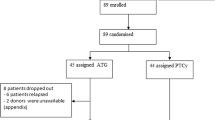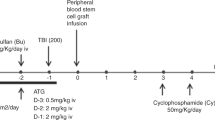Summary:
In patients with poor-risk relapse of aggressive lymphoma, reduced-intensity conditioning followed by allogeneic PBSCT may have its limitations because of rapid regrowth of the tumor. We tried to address this problem by intermediate-intensity conditioning followed by allogeneic SCT. A total of 21 patients received fludarabine, busulfan and cyclophosphamide prior to allogeneic SCT. In the first 10 patients, GVHD prophylaxis by CD34+ selection of the grafts was employed (group I). The next 11 patients received nonmanipulated grafts and mycophenolat mofetil plus cyclosporinA (group II). In group I, no GVHD was observed. In contrast, patients in group II had a significant risk of acute GVHD (aGVHD) (six patients with grade II–IV acute GVHD). However, in group I, all surviving patients progressed within 9 months. In contrast, eight of nine surviving patients of group II remain in remission after a median observation time of 10.5 months (range 4–22 months). Survival differed significantly between the groups (P=0.004). Multivariate analysis identified intensive GVHD prophylaxis as important risk factor for survival. These results support the existence of a clinically relevant GVL effect in aggressive lymphoma. T-cell depletion (or CD34 selection) of grafts is not recommended in patients with poor-risk aggressive NHL.
This is a preview of subscription content, access via your institution
Access options
Subscribe to this journal
Receive 12 print issues and online access
$259.00 per year
only $21.58 per issue
Buy this article
- Purchase on Springer Link
- Instant access to full article PDF
Prices may be subject to local taxes which are calculated during checkout


Similar content being viewed by others
References
Blay J, Gomez F, Sebban C et al. The International Prognostic Index correlates to survival in patients with aggressive lymphoma in relapse: analysis of the PARMA trial. Parma Group. Blood 1998; 92: 3562–3568.
Guglielmi C, Gomez F, Philip T et al. Time to relapse has prognostic value in patients with aggressive lymphoma enrolled onto the Parma trial. J Clin Oncol 1998; 16: 3264–3269.
Verdonck LF, Dekker AW, Lokhorst HM et al. Allogeneic versus autologous bone marrow transplantation for refractory and recurrent low-grade non-Hodgkin's lymphoma. Blood 1997; 90: 4201–4205.
Glass B, Ruiz de Elvira C, Schmitz N . Salvage therapy after high-dose therapy (HDT) and autologous stem cell transplantation (SCT): allogeneic or autologous second transplant in lymphoma, a retrospective analysis of the EBMT. Bone Marrow Transplant 2002; 29 (Suppl. 2) (Abstract).
Bertz H, Illerhaus G, Veelken H, Finke J . Allogeneic hematopoetic stem-cell transplantation for patients with relapsed or refractory lymphomas: comparison of high-dose conventional conditioning versus fludarabine-based reduced-intensity regimens. Ann Oncol 2002; 13 (1): 135–139.
Corradini P, Tarella C, Olivieri A et al. Reduced-intensity conditioning followed by allografting of hematopoietic cells can produce clinical and molecular remissions in patients with poor-risk hematologic malignancies. Blood 2002; 99 (1): 75–82.
Dreger P, Glass B, Seyfarth B et al. Reduced-intensity allogeneic stem cell transplantation as salvage treatment for patients with indolent lymphoma after failure of autologous SCT. Bone Marrow Transplant 2000; 26: 1361–1362.
Robinson SP, Goldstone AH, Mackinnon S et al. Chemoresistant or aggressive lymphoma predicts for a poor outcome following reduced-intensity allogeneic progenitor cell transplantation: an analysis from the Lymphoma Working Party of the European Group for Blood and Bone Marrow Transplantation. Blood 2002; 100 (13): 4310–4316.
Branson K, Chopra R, Kottaridis PD et al. Role of nonmyeloablative allogeneic stem-cell transplantation after failure of autologous transplantation in patients with lymphoproliferative malignancies. J Clin Oncol 2002; 20: 4022–4031.
Lush RJ, Haynes AP, Byrne J et al. Allogeneic stem-cell transplantation for lymphoproliferative disorders using BEAM-CAMPATH (+/− fludarabine) conditioning combined with post-transplant donor-lymphocyte infusion. Cytotherapy 2001; 3: 203–210.
Kobbe G, Schneider P, Aivado M et al. Reliable engraftment, low toxicity, and durable remissions following allogeneic blood stem cell transplantation with minimal conditioning. Exp Hematol 2002; 30: 1346–1353.
Philip T, Guglielmi C, Hagenbeek A et al. Autologous bone marrow transplantation as compared with salvage chemotherapy in relapses of chemotherapy-sensitive non-Hodgkin's lymphoma. N Engl J Med 1995; 333: 1540–1545.
Schmitz N, Pfistner B, Sextro M et al. Aggressive conventional chemotherapy compared with high-dose chemotherapy with autologous haemopoietic stem-cell transplantation for relapsed chemosensitive Hodgkin's disease: a randomised trial. Lancet 2002; 359: 2065–2071.
Hanel M, Kroger N, Sonnenberg S et al. Busulfan, cyclophosphamide, and etoposide as high-dose conditioning regimen in patients with malignant lymphoma. Ann Hematol 2002; 81: 96–102.
Caballero MD, Rubio V, Rifon J et al. BEAM chemotherapy followed by autologous stem cell support in lymphoma patients: analysis of efficacy, toxicity and prognostic factors. Bone Marrow Transplant 1997; 20: 451–458.
Wheeler C, Strawderman M, Ayash L et al. Prognostic factors for treatment outcome in autotransplantation of intermediate-grade and high-grade non-Hodgkin's lymphoma with cyclophosphamide, carmustine, and etoposide. J Clin Oncol 1993; 11: 1085–1091.
Josting A, Franklin J, May M et al. New prognostic score based on treatment outcome of patients with relapsed Hodgkin's lymphoma registered in the database of the German Hodgkin's lymphoma study group. J Clin Oncol 2002; 20: 221–230.
Ratanatharathorn V, Uberti J, Karanes C et al. Prospective comparative trial of autologous versus allogeneic bone marrow transplantation in patients with non-Hodgkin's lymphoma. Blood 1994; 84: 1050–1055.
van Besien K, Thall P, Korbling M et al. Allogeneic transplantation for recurrent or refractory non-Hodgkin's lymphoma with poor prognostic features after conditioning with thiotepa, busulfan, and cyclophosphamide: experience in 44 consecutive patients. Biol Blood Marrow Transplant 1997; 3: 150–156.
Magalhaes-Silverman M, Lister J, Rybka W et al. Busulfan and cyclophosphamide (BU/CY2) as preparative regimen for patients with lymphoma. Bone Marrow Transplant 1997; 19: 777–781.
Schiffman K, Buckner CD, Maziarz R et al. High-dose busulfan, melphalan, and thiotepa followed by autologous peripheral blood stem cell transplantation in patients with aggressive lymphoma or relapsed Hodgkin's disease. Biol Blood Marrow Transplant 1997; 3: 261–266.
Kroger N, Hoffknecht M, Hanel M et al. Busulfan, cyclophosphamide and etoposide as high-dose conditioning therapy in patients with malignant lymphoma and prior dose-limiting radiation therapy. Bone Marrow Transplant 1998; 21: 1171–1175.
Juckett M, Rowlings P, Hessner M et al. T cell-depleted allogeneic bone marrow transplantation for high-risk non-Hodgkin's lymphoma: clinical and molecular follow-up. Bone Marrow Transplant 1998; 21: 893–899.
Perez-Simon JA, Kottaridis PD, Martino R et al. Nonmyeloablative transplantation with or without alemtuzumab: comparison between 2 prospective studies in patients with lymphoproliferative disorders. Blood 2002; 100: 3121–3127.
Author information
Authors and Affiliations
Corresponding author
Rights and permissions
About this article
Cite this article
Glass, B., Nickelsen, M., Dreger, P. et al. Reduced-intensity conditioning prior to allogeneic transplantation of hematopoietic stem cells: the need for T cells early after transplantation to induce a graft-versus-lymphoma effect. Bone Marrow Transplant 34, 391–397 (2004). https://doi.org/10.1038/sj.bmt.1704600
Received:
Accepted:
Published:
Issue Date:
DOI: https://doi.org/10.1038/sj.bmt.1704600
Keywords
This article is cited by
-
Allogeneic stem cell transplantation for patients with relapsed or refractory T-cell lymphoma: efficacy of lymphoma-directed conditioning against advanced disease
Bone Marrow Transplantation (2019)
-
Loss of donor chimerism in remission after allogeneic stem cell transplantation of T-prolymphocytic leukemia patients following alemtuzumab induction therapy
International Journal of Hematology (2014)
-
Fludarabine phosphate and melphalan: a reduced intensity conditioning regimen suitable for allogeneic transplantation that maintains the graft versus malignancy effect
Bone Marrow Transplantation (2006)
-
Graft-versus-tumor effects on murine mammary carcinoma in a model of nonmyeloablative haploidentical stem cell transplantation
Bone Marrow Transplantation (2006)
-
Reduced intensity conditioning and allogeneic stem cell transplantation after salvage therapy integrating alemtuzumab for patients with relapsed peripheral T-cell non-Hodgkin's lymphoma
Bone Marrow Transplantation (2005)



